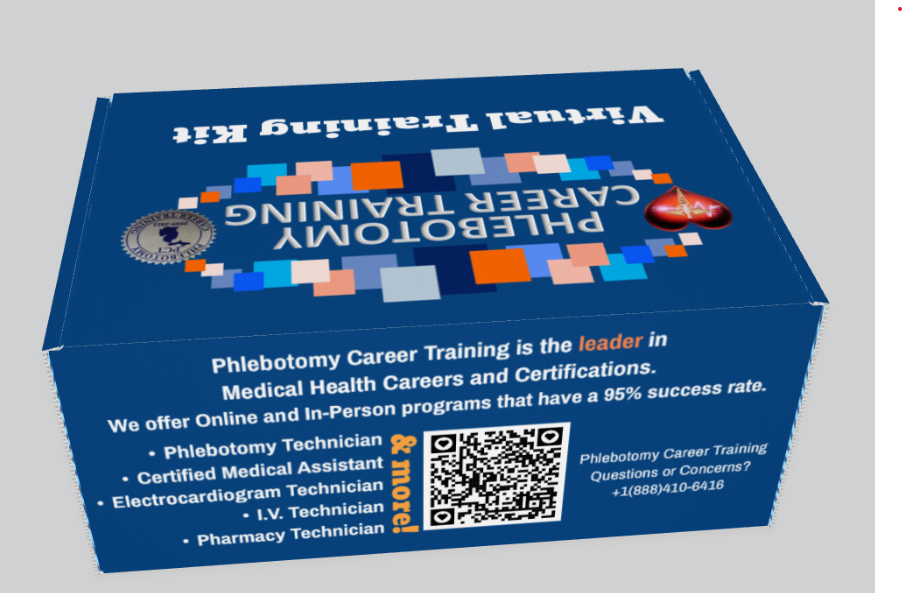5 Reasons Why Every Phlebotomy Student Should Use a Practice Arm
Becoming a phlebotomist is a great way to start a new career. However, every new career, especially in the medical field requires skill. That skill is only learned through practice. Phlebotomy Career Training understands the need to provide students the opportunity to practice their skills. This is why Phlebotomy Career Training designed and patented their Virtual Training Arm. Every student of phlebotomy online receives a VSK or Virtual Simulation Kit. This VSK includes the supplies that are necessary to learn how to draw blood.
The first reason that students should use their VSK
Students should use their VSK to be able to visually identify all the equipment that they will use in the real world. Students will learn the names and uses of each of their phlebotomy equipment, such as their vacutainer needle, vacutainer hub, butterfly needle and vacutainer tubes.
The second reason that phlebotomy students should practice on a VSK
Practicing on a simulated arm helps students get over the fear of drawing on a real person. Much of phlebotomy is muscle memory. At Phlebotomy Career Training, we want students to practice at least 100 times weekly using their VSK. The steps provided to students from our teachers and videos helps to demonstrate the correct way to draw blood. Yes, there is a correct way! Every step of a blood draw is outlined for students so that they can see the how and why these steps are performed. Did you know that there is scientifically evidenced based literature on why the angle of the needle is important as well as how to properly cleanse the area.
The third reason why it is important that students use their VSK
Repetition makes perfect. A thorough knowledge of each step helps students build the confidence they need to go out into the world knowing that they have learned the correct steps of phlebotomy. As a matter of fact, our students at Phlebotomy Career Training, usually wind up showing seasoned phlebotomist what they have been doing wrong. Though this doesn’t make them very popular, protecting patients from harm is the only goal for each of our graduates.
The fourth reason why it is important to use their VSK
When students practice on their VSK, they are required to send in a video to their online instructor demonstrating their technique. Their personal online instructor provides detailed feedback to the student and will request a re-do in certain circumstances until the student gets it right. Students can also watch other students videos demonstrating their blood draws using the practice arm. Learning takes place with doing, listening, watching and integrating new knowledge.
The fifth reason that students should use their VSK
Finding veins! Yes, finding veins is the bane of all phlebotomists, regardless of how long they have been in the field. Which is why that Phlebotomy Career Training designed the veins in the practice arm to mimic actual vein anatomy. Bifurcating veins can be a real issue and is one of the main reasons that phlebotomists miss the vein. The term, “Palpation” is frequently used in phlebotomy to describe the touching of the vein by the phlebotomists by applying slight pressure to identify where the vein lies and its diameter. The veins in the VSK are palpable and also bifurcate so that if as student closes their eyes they can feel the veins under the skin and trace the veins direction in the arm.
Phlebotomy Career Training puts emphasis on patient interaction and compassion
Student must also practice introducing themselves to their patients. Every patient has the right to know who is going to be taking care of them or who is drawing their blood. Phlebotomy Career Training wants every student to introduce themselves using their first and last name as well as their title. For instance, the student will say, “Good morning, my name is Mary Doe. I am going to be your phlebotomist today. May I have permission to draw your blood?”
This short introduction does much in the way of providing respect and autonomy to the patient. First the student tells the patient who they are, and secondly they ask the patient’s permission. Every patient has the right to say,”No”!
Students at Phlebotomy Career Training are taught to label all of their blood specimens at the bedside once they have completed their blood draw. This provides an extra assurance that they have collected blood on the right patient.
Identification of the patient is crucial. Student are taught to ask the patient to state their name, spell their name and provide their date of birth. Many people have similar sounding names but may be spelled differently. Proper protocol is especially critical so as not to draw blood on the wrong patient.
The Agency for Healthcare Research and Quality have detailed meta analysis research on the best practices for identifying patients and preventing gross errors that can result in providers prescribing errors. Phlebotomy Career Training follows these guidelines so that our graduate students will be less inclined to make errors of patient identification.
Knowing these rules and guidelines and practicing their introduction and patient identification questions are all part of the students blood draw skills. The students will go through all these procedures during their video which they will submit to their instructor.
At the end of their course, the student will feel competent and ready to out into the world as a phlebotomist. While is will be somewhat intimidating at first, they will be glad that they learned the correct methods and procedures, thereby keeping their patients safe and respecting their patient dignity and rights.
van Dongen-Lases EC, Cornes MP, Grankvist K, et al. Patient identification and tube labelling – a call for harmonisation. Clinical Chemistry and Laboratory Medicine (CCLM). 2016;54(7). doi:10.1515/cclm-2015-1089.
This article is written by Nancy Lydia Kimmel RN, MSN, FNP-BC
Nancy Kimmel is a Family Nurse Practitioner specializing in the care of adults and children.


Nancy L. Kimmel obtained her PhD in Environmental Engineering in 2002, then went on to teach Physics and Mechanical Engineering at Lawrence Technological University, Henry Ford College and Oakland University. She obtained her Associate in Nursing from Henry Ford College and then went on to earn her Master Degree as a Family Nurse Practitioner and became Board Certified working as a licensed FNP in the State of Michigan. She then went on to Medical School where she is now in her 3rd year, and is also in the process of obtaining her Doctorate in Nursing Practice through Chamberlin University. She has authored the NET Study Guide, as well a several books on subjects of Math, ECG/EKG and Phlebotomy. She holds a patent on an Air Filter through the U.S. Patent Office.


